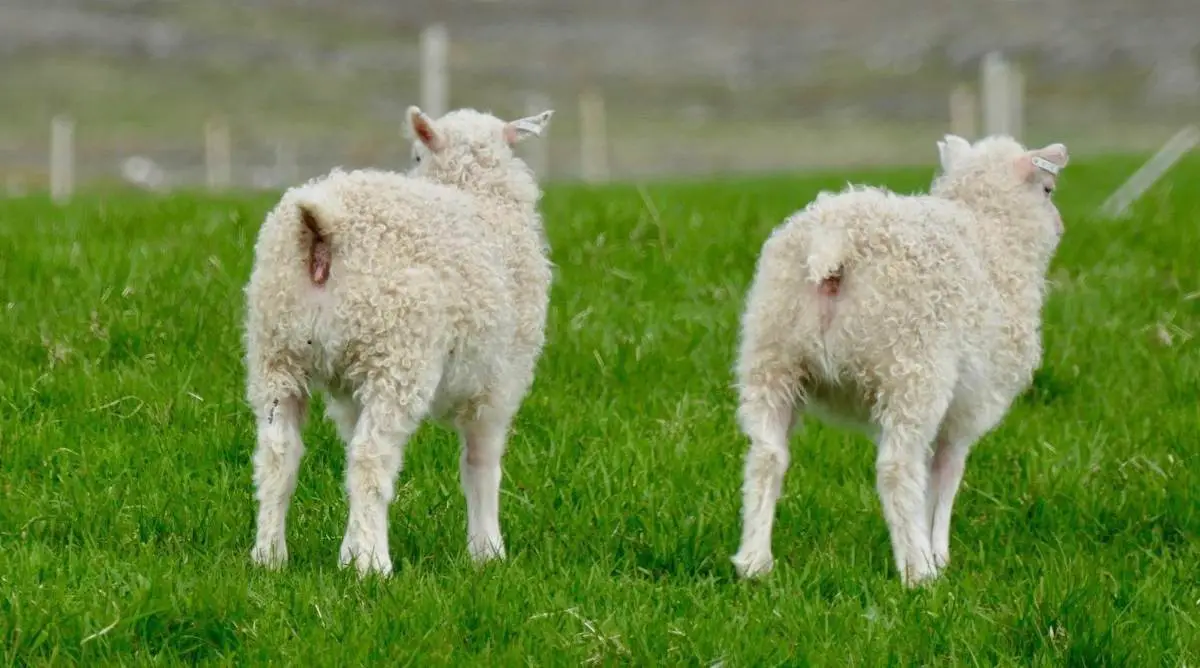Tail docking is a common flock management practice intended to prevent flystrike and make shearing easier. Tail docking is painful for sheep, and when tails are docked too short, it can make flystrike worse. It should be done carefully and only if necessary for your particular breed of sheep (many hair sheep breeds do not need to be docked).
Table of Contents
Is docking sheep right for your flock?
Understanding whether tail docking is right for your sheep requires looking at the breed and tail length of your sheep.
Many hair sheep breeds do not need to be docked because they have no wool for feces and urine to get stuck in. Other sheep have short tails naturally, and they may be short enough to not require docking.
Sheep tails shouldn’t be completely docked, because doing so increases the risk of rectal prolapse and vaginal prolapse. Typically, the tail is docked at the third joint. In the United Kingdom, the law states that the tails must remain at least long enough to cover the anus of ram lambs and the vulva of ewe lambs.
The risk of flystrike
All sheep are born with a tail. Tail docking originated because the tails of sheep (especially of wool sheep) tend to lead to dung and urine collecting on their rear ends, which stains the wool and attracts blowflies.
The blowflies lay eggs in the sheep’s wool, and the resulting maggots eat the sheep’s skin. It’s an irritating and potentially fatal condition for the sheep.
Tail docking reduces the chance of this happening.
Docking Methods

Banding
Banding is the easiest and most commonly used docking method for docking sheep. It is done by applying a rubber ring to the sheep’s tail using a ring extender or elastrator. Banding cuts off the tail’s blood supply, which then causes the tail to atrophy and fall off after a few weeks.
This can cause pain to the lamb, but it can be reduced with the help of a Burdizzo, or a clamp, that is applied across the tail. The lamb should at least be a day old before this can be done, or else colostrum intake and maternal bonding may be disrupted.
Bands should only be applied during the first week of life of the lamb. Other tail docking methods are necessary for older sheep.
Blade
With this method, a gas-heated surgical knife’s blade is used for cutting. Then, the wound is cauterized to prevent blood loss.
This method is quick, hygienic, and ideal for older lambs up to two months of age.
Clamping and Surgery
This method requires a professional veterinarian. Unlike other ways of docking, there’s the use of anesthesia and surgery.
The vet performs a two-stage process. First, a clamp is put on the tail. Then, after waiting for three days, the tail is surgically removed. The method gives your sheep’s tail a neat appearance.
An argument for docking sheep
Advantages to docking sheep include:
- Reducing the likelihood of flystrike
- Make it easier to shear sheep
- Keeping milk clean as sheep are milked
In general, having a flock of docked sheep also makes management easier for farmers.
An argument against docking sheep

Reasons to be cautious about docking sheep include:
- Docking the tail too short can increase the incidence of rectal and vaginal prolapse.
- Fat-tail sheep also have energy stores in their tails, and docking them would be detrimental to their health.
- Docking causes pain and stress in the sheep, which is why the British Veterinary Association suggests that docking should be a last resort option. According to the FAWC report, physiological and behavioural responses indicate that tail docking causes pain.
- Flystrike may still happen, since when sheep lose their tails, they lose their ability to swat away flies.
- Certain breeds that have short tails already do not need to be docked anymore, such as the American Blackbelly, Dorper, St. Augustine, and Romanov.
Tail docking (by breed)
These breeds generally need to be docked:
- Merino
- Dorset
- Polypay
- Hampshire
- Suffolk
These breeds generally do no need to be docked:
- Barbados Blackbelly
- Damara
- Katahdin
- Royal White
- Santa Ines
- East Friesian
- Finn Sheep
- Gotland
- Icelandic
- Soay

